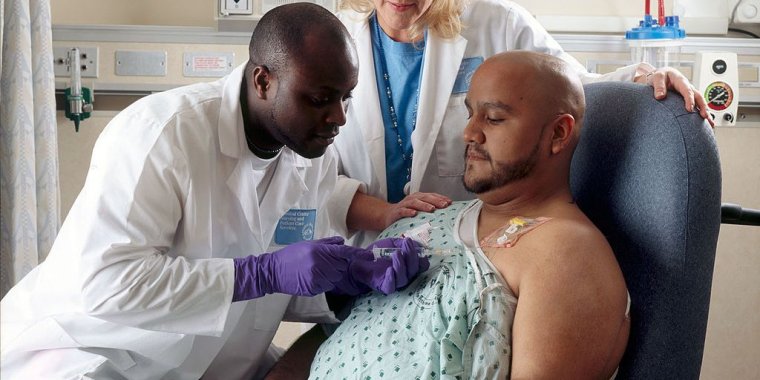| Health / Health News |
Study finds elevated risk of certain rare blood cancers after chemotherapy for most solid tumors
Advances in treatment over the last several decades have resulted in improved survival for patients with many types of cancer. However, survivors may be at increased risk of developing a subsequent treatment-related cancer. In this study, researchers aimed to quantify the risk of developing tMDS/AML, a rare but often fatal blood cancer, in patients treated with chemotherapy.

Patient receives chemotherapy. Image credit: Rhoda Baer/NIH
The development of myeloid leukemia is a very rare adverse effect of some types of cancer treatments that damage cell.
The researchers analyzed NCI’s Surveillance, Epidemiology, and End Results (SEER) program registry data on more than 700,000 patients age 20–84 in the United States with solid tumors who were diagnosed and treated with initial chemotherapy during 2000–2013 and survived at least one year after diagnosis.
Of these patients, 1,619 developed tMDS/AML through 2014. When the researchers analyzed the risk of tMDS/AML by original cancer type, they found that risk was increased by 1.5-fold to more than 10-fold for 22 of the 23 solid cancer types investigated (all except colon cancer).
These findings expand the groups of survivors at risk of tMDS/AML following treatment with chemotherapy because, in the past, excess risks were established only after chemotherapy for cancers of the lung, ovary, breast, soft tissue, testis, and brain/central nervous system.
In the present analysis, cumulative incidence of tMDS/AML was less than 1 percent at 10 years after chemotherapy for most solid cancer types. However, prognosis following tMDS/AML diagnosis was very poor.
During the study period, 2000–2013, there was a substantial rise in use of platinum-based chemotherapy agents, from 57 percent of patients in 2000–2001, to 81 percent of patients in 2012–2013. Platinum-based chemotherapy agents are known to increase risk of tMDS/AML.
The most important message from this study is that, while advances in cancer treatment approaches have improved the prognosis for many types of cancer, the number of patients at risk of developing rare, therapy-related leukemia after cancer chemotherapy in the modern treatment era has markedly expanded.
Assessments of treatment risks and benefits should balance these risks and other adverse effects of chemotherapy against potential gains in survival following treatment for the initial solid cancer. (National Institutes of Health)
YOU MAY ALSO LIKE


